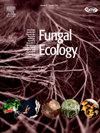Phenology of rust fungi (Pucciniales) during mild winters – high temporal flexibility of spore generations
IF 2.2
3区 环境科学与生态学
Q3 ECOLOGY
引用次数: 0
Abstract
Rust fungi develop up to five spore generations that often infect host plants of two different families in one life cycle. We investigated the phenology of spore generations over winter by monitoring rust infections over ten years in urban, wild vegetation in Western Germany. We obtained 1177 records of plants infected by 33 species of rust fungi. We observed basidia (mostly inferred from empty teliospores), spermogonia, and aecia mostly during spring, maximum development of urediniospores during summer and of telia in autumn and winter. Surprisingly, during winter months with mild temperatures, newly developed urediniospores on perennial hosts were frequently found, sometimes showing massive growth. Other spore generations also sporadically occurred at unusual times of the year. By their high number and diversity of spore generations as well as great phenological flexibility, rust fungi probably easily adapt to changing weather conditions.
暖冬时期锈菌的物候学——孢子世代的高时间灵活性
锈菌在一个生命周期内可产生多达五代孢子,通常感染两个不同科的寄主植物。我们通过监测德国西部城市野生植被10年以上的锈病感染,研究了孢子代冬季的物候特征。共获得33种锈菌侵染植物1177份记录。我们观察到担子孢子(主要来自空的端孢子)、精原体和无孢子体主要在春季发育,尿素孢子的最大发育期在夏季,端孢子的最大发育期在秋冬。令人惊讶的是,在气温温和的冬季,经常发现多年生寄主上新发育的脲孢子,有时会出现大量生长。其他孢子代也偶尔发生在一年中的不寻常时间。由于其孢子的数量和多样性以及物候的灵活性,锈菌可能很容易适应不断变化的天气条件。
本文章由计算机程序翻译,如有差异,请以英文原文为准。
求助全文
约1分钟内获得全文
求助全文
来源期刊

Fungal Ecology
环境科学-生态学
CiteScore
5.80
自引率
3.40%
发文量
51
审稿时长
3 months
期刊介绍:
Fungal Ecology publishes investigations into all aspects of fungal ecology, including the following (not exclusive): population dynamics; adaptation; evolution; role in ecosystem functioning, nutrient cycling, decomposition, carbon allocation; ecophysiology; intra- and inter-specific mycelial interactions, fungus-plant (pathogens, mycorrhizas, lichens, endophytes), fungus-invertebrate and fungus-microbe interaction; genomics and (evolutionary) genetics; conservation and biodiversity; remote sensing; bioremediation and biodegradation; quantitative and computational aspects - modelling, indicators, complexity, informatics. The usual prerequisites for publication will be originality, clarity, and significance as relevant to a better understanding of the ecology of fungi.
 求助内容:
求助内容: 应助结果提醒方式:
应助结果提醒方式:


